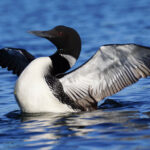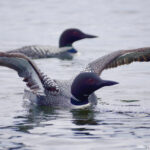Creature Feature – Welcome Back Loonies
Posted by Dustin Horton // April 16, 2024 // Articles, Creature Feature
I heard the first loon of the year on Easter morning. Otisco Lake is downhill from my home, and on early spring days, the loons can be heard from my backyard. There’s nothing quite like the haunting vocalizations of Common Loons, especially after a long winter, and I wish they would stick around. Alas, Otisco Lake fails to attract nesting loons. Instead, it serves as a pit stop for migrating loons heading to their breeding territories in the Adirondacks, New England, and Canada.
This spring, certain lakes saw loons arriving a little earlier than usual. Some younger loons are making their very first trip back north from wintering grounds along the Atlantic coast, where they’ve spent the last 2-3 years. Once arrived, these individuals tend to wander between lakes over the next few breeding seasons before finally settling on a lake to mate—usually the same waterbody where they hatched or another close by.
Loons exhibit high “site fidelity,” meaning once settled on a breeding territory, they return to the same lake every spring, year after year, unless driven off by an opponent. Despite common belief, loons don’t mate for life. The average pair bond lasts between 6-7 years and typically breaks when one of the mates loses to a challenger or when a partner doesn’t return in the spring. There are known exceptions to the norm, however, and some loon pairs have remained together much longer. Take Seney National Wildlife Refuge’s famous couple “ABJ” and “Fe” that stayed together for 25 consecutive years!
Article & photo by Margie Manthey















